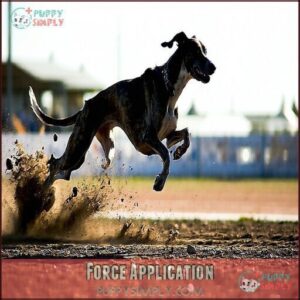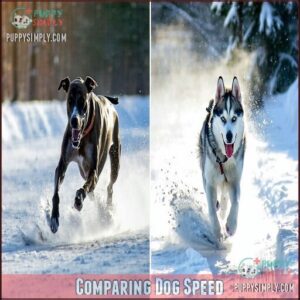This site is supported by our readers. We may earn a commission, at no cost to you, if you purchase through links.
 Dogs can run surprisingly fast, with speeds ranging from 15 to 45 miles per hour depending on their breed, size, and health.
Dogs can run surprisingly fast, with speeds ranging from 15 to 45 miles per hour depending on their breed, size, and health.
Greyhounds hold the crown for top speed, reaching an incredible 45 mph, thanks to their long legs and sleek bodies. Most dogs, like Labradors or German Shepherds, average around 20-30 mph, enough to leave most humans in the dust.
Age, weight, and fitness play big roles too—puppies and seniors are more about wagging tails than breaking records. If you’ve ever watched a dog sprint fully freed, it’s like watching joy in motion.
But speed’s not everything, right? Stamina matters too!
Table Of Contents
Key Takeaways
- You’ll find Greyhounds are the fastest dogs, reaching up to 45 mph, while most dogs average 15-20 mph with bursts closer to 30 mph.
- A dog’s speed depends on breed, anatomy, and fitness—longer legs, lean bodies, and stamina give certain breeds an edge.
- Sprinting breeds like Greyhounds excel in short bursts, while endurance breeds like Huskies can run long distances up to 50 miles.
- Proper training, health check-ups, and avoiding hot or rough terrain are essential for safely maximizing your dog’s running potential.
Dog Running Speeds
You’ll be amazed to learn that dogs can reach impressive speeds, with the fastest breeds like Greyhounds clocking in at 45 mph.
Greyhounds, the ultimate speedsters, can hit an astonishing 45 mph, leaving even the fastest human sprinters far behind.
Your canine companion’s speed depends on factors like breed, size, and body structure, with longer legs and leaner bodies generally resulting in faster running abilities, and most average dogs run between 15-20 mph while utilizing their body structure.
Factors Influencing Speed
Anatomy plays a vital role in your dog’s speed.
Limb length, muscle mass, and oxygen intake directly impact how fast they can run.
Longer legs generally mean faster speeds, while a dog’s overall health determines stamina.
Dog breeds with specific purposes, like hunting or herding, typically show higher dog top speed capabilities.
Notably, your pup’s running ability also depends on their body structure and cardiovascular efficiency.
Breed Characteristics
In terms of dog breeds speed, each breed’s characteristics influence how quickly they can move.
Sighthounds like Greyhounds have been bred throughout history for coursing game, making them the fastest dog breeds today.
Working dogs developed stronger endurance while terriers were bred for quick bursts to chase vermin.
Understanding breed purpose and history helps explain why your Border Collie and Basset Hound run at such different speeds.
Physical Traits
You’ll notice certain physical traits that directly impact dog speed.
Long, muscular legs provide greater stride length, while lean muscle mass delivers explosive power.
Deep chests allow for expanded lung capacity during sprints.
Even paw pads play a role – they’re designed for grip and shock absorption.
A dog’s overall body size, canine anatomy, and athletic build work together as a finely-tuned speed machine.
How Fast Can Dogs Run
You’ve likely wondered just how fast your furry friend can really move when chasing after that squirrel. Dogs’ running capabilities vary dramatically depending on their breed, size, and health.
The average dog speed falls between 15-20 mph during regular running, but many can reach impressive bursts of 30 mph during short sprints.
When discussing dog top speed, it’s essential to understand these factors:
- Canine biomechanics play a vital role—dogs with longer legs and leaner bodies typically run faster
- Different breeds utilize distinct running styles, from the "double suspension gallop" of Greyhounds to the efficient trotting of herding dogs
- Speed vs. breed correlations are strong but individual variation exists within each breed
- Speed training can improve your dog’s performance, but breed limitations will always set natural ceilings.
Some breeds, like the fastest dog breeds, are naturally built for incredible speed.
Fastest Dog Breeds
You’ll be amazed at how these lightning-fast canines can leave your family car in the dust, with Greyhounds topping the charts at an impressive 45 mph.
From the ancient Saluki reaching 42 mph to the compact Whippet sprinting at 35 mph, these speedy breeds showcase nature’s perfect engineering for pure velocity.
Greyhounds
Now we’ll look at the undisputed champion of canine speed – the Greyhound.
The Greyhound, nature’s ultimate racing machine, flies at 45 mph with 75% of its stride spent airborne.
These sleek sighthounds can reach an astonishing 45 mph, making them the second fastest land animal after cheetahs.
With their aerodynamic skulls, deep chests, and bodies that spend 75% of running time airborne, Greyhounds are nature’s perfect racing machines.
Their double suspension gallop and powerful legs with 80% fast-twitch muscle fibers contribute to their remarkable velocity.
Salukis
While Greyhounds get most of the speed glory, Salukis are the marathon runners of the canine world.
These ancient sighthounds clock impressive speeds up to 43 mph, making them the second fastest dog breed.
What makes Salukis exceptional runners:
- Incredible stamina – they can maintain high speeds over longer distances than Greyhounds
- Deep-chested build provides superior lung capacity
- 5,000-year hunting heritage from the Arabian Peninsula
They’re both elegant couch potatoes and remarkable athletes.
Whippets
The sleek, elegant Whippet comes in as the fifth fastest dog breed, capable of reaching speeds up to 35 mph.
These British sighthounds pack impressive acceleration into their medium-sized frames.
| Feature | Description | Benefit |
|---|---|---|
| Speed | 35 mph top speed | Fastest for their weight class |
| Temperament | Gentle, affectionate | Perfect family companions |
| History | Originally bred for hunting | Natural athletic ability |
Whippets combine explosive speed with a calm, loving nature at home, making them perfect family companions with a natural athletic ability.
Afghan Hounds
Occasionally called the "runway models" of the dog world, Afghan Hounds combine beauty with impressive sighthound speed, reaching up to 40 mph.
These majestic runners stand 25-27 inches tall and weigh 50-60 pounds.
- Afghan temperament leans toward independence, making training a patient endeavor
- Breed history traces back thousands of years as desert hunters
- Grooming needs are significant due to their flowing silky coat
- Exercise requirements include secure areas for safe running
- Health concerns include sensitivity to anesthesia
Vizslas
Vizslas rank among the fastest dog breeds, speeding up to 40 mph with energy that seems endless.
With a rich history as Hungarian hunting dogs, their stamina and temperament make them incredible running partners.
Regular Vizsla training guarantees peak dog speed and health.
| Feature | Detail |
|---|---|
| Top Speed | 40 mph |
| Origin | Hungary |
| Key Trait | High Stamina |
| Temperament | Energetic, Friendly |
| Ideal for | Active Owners |
Average Dog Running Speed
You’ll find that most healthy dogs can run at an average speed of 15-20 mph, which might leave you in the dust during your next game of fetch.
While this sustainable pace works for everyday activities, many breeds can reach impressive top speeds of 30-45 mph during short bursts when properly motivated, often reaching their top speeds.
Sustainable Pace
While most dogs can maintain speeds of 15-20 mph for extended periods, this sustainable pace varies based on breed stamina and physical fitness.
Your dog’s endurance depends on energy expenditure during exercise, which is affected by terrain impact and training effect.
Regular conditioning improves your dog’s health and allows them to run comfortably without overexertion, which guarantees they can enjoy longer runs while preserving their stamina for daily activities.
Top Speed
While most pups maintain consistent speeds, their top speed can be jaw-dropping.
Greyhounds lead the pack, reaching peak velocities of 45 mph, with Salukis following at 42 mph. Your Afghan Hound or Vizsla can hit 40 mph during short sprints.
These fastest dogs can’t sustain their sprint duration for long—it’s like watching canine records being broken in quick bursts. Speed sustainability depends entirely on breed potential and individual fitness.
The fastest dog breeds include the Doberman Pinscher, known for security work.
Distance Running
While top speeds are impressive, your dog’s endurance determines how far they can run.
Most canines maintain speeds around 15 mph for hours at a time. Some breeds excel at longdistance running, with proper endurance training allowing them to cover impressive distances.
A well-conditioned Weimaraner once completed a mile in just 4:30! Breed stamina varies substantially, so consider your pup’s natural abilities before planning extended running sessions.
Dog Running Ability
Your dog’s running ability depends on several key factors including age, weight, health status, and the terrain they’re running on.
You’ll notice significant differences in how your furry friend performs based on these conditions, with younger, healthier dogs typically outpacing seniors or those carrying extra pounds, which can be influenced by their overall health status.
Age Factors
Your pet’s age substantially impacts their dog speed capabilities.
Puppies under 18 months shouldn’t engage in sustained running as their developing bones and joints are vulnerable to age-related injuries.
Puppy running speed naturally increases during development, peaking in adulthood (2-5 years).
Senior dogs gradually lose speed and endurance, requiring training adjustments as they age.
Consider your dog’s lifespan impact when planning activities—what’s appropriate changes throughout their life.
Weight Factors
Just as age affects your four-legged friend’s speed, their weight plays a significant role too.
Carrying extra pounds slows down dog speed dramatically – an overweight Labrador won’t match the performance of one at ideal breed weight.
Obesity impact extends beyond just reduced speed; it strains joints and decreases endurance.
Body composition matters greatly – muscular dogs with proper weight training maintain better speed than those with excess fat, regardless of dog breed size, due to their ideal breed weight and proper weight training.
Health Issues
Your dog’s health directly impacts how fast they can run.
Just like a car needs maintenance, your pup needs to be in good shape to hit top speeds.
Common health issues affecting dog speed include:
- Joint problems like arthritis can make running painful
- Heart conditions limit stamina and endurance
- Breathing issues, especially in brachycephalic breeds, restrict oxygen flow
Always check with your veterinarian before starting a running routine with your dog to prevent injuries and guarantee proper dog physical fitness.
Terrain Conditions
Five different terrain conditions can dramatically affect your dog’s running ability.
Hard surfaces like concrete increase Surface Impact risks, while sandy beaches slow their pace.
Incline Effects are real—your pup will tire faster on hills than flat paths.
Weather Influence matters too; hot pavement can burn paws while snow may cause slipping.
Consider Trail Safety and Footing Stability based on your dog’s breed terrain preferences.
Breeds Suited for Running
You’ll find sporting breeds, working dogs, terriers, and retrievers at the front of the pack when looking for running companions.
These athletic breeds combine powerful muscles, efficient breathing, and natural stamina that make them perfect partners for your morning jogs or weekend trail adventures, with natural stamina being a key factor.
Sporting Breeds
Now that we’ve a grasp of what affects a dog’s running ability, let’s look at sporting breeds – the athletes of the dog world!
Weimaraners and German Shorthaired Pointers exhibit remarkable stamina and energy levels perfect for outdoor activities. Their hunting instincts make them natural runners.
Rhodesian Ridgebacks showcase impressive canine velocity, while English Springer Spaniels deliver outstanding endurance. Brittany Spaniels are particularly difficult to tire out, thanks to their exceptional work ethic and breed variations in athleticism.
Remember to keep in mind age and fitness before starting a running routine.
Working Breeds
While sporting breeds excel at field work, working breeds were designed for endurance and raw power.
German Shepherds and Belgian Malinois need vigorous daily exercise to stay happy. Dalmatians, with their impressive guard dog stamina, were literally bred to run alongside carriages.
Huskies showcase remarkable sled dog endurance, craving physical work. And let’s not forget Greyhounds – these canine velocity champions were built for running with unmatched dog athleticism, demonstrating their dog athleticism.
Terriers
Frequently underestimated due to their size, terriers deliver impressive dog running speed with remarkable terrier agility.
Border Collies practically live to expend energy, making them excellent companions for extended runs.
Australian Cattle Dogs excel at mid-distance running, while Jack Russell Terriers—among the fastest dogs in the small dog speed category—are ideal daily running partners.
Their spirited terrier temperament and boundless energy guarantee you’ll never run alone again, thanks to their impressive dog running speed.
Retrievers
Retriever breeds make exceptional running companions for your daily jogs.
Labrador Retrievers are ideal for runners seeking a faithful training buddy, while Golden Retrievers’ thick coats make them perfect for cold-weather runs.
If you’re looking for impressive dog running speeds, Vizslas stand out among retrievers with their remarkable endurance and athleticism.
These dog breeds combine friendly temperaments with natural athletic ability, making them your perfect pace-setters.
Factors Affecting Dog Speed
You’ll find that your dog’s speed depends on several key factors including breed, body shape, leg length, and overall health.
Whether you have a speedy Greyhound built for sprinting or a stockier breed that moves at a more leisurely pace, understanding these elements can help you set realistic expectations for your furry running partner.
Limb Optimization
While many dogs make excellent running partners, their limb optimization is what transforms them into speed demons.
You’ll notice the fastest dogs have specific anatomical advantages:
- Longer limb length creates greater stride distance with each step
- Enhanced joint flexibility allows for maximum extension during running
- Specialized paw structure provides ideal grip and push-off power
- Strategic muscle attachment points generate more efficient force
This perfect design lets Greyhounds and other speedy breeds reach impressive speeds with minimal energy expenditure, thanks to their anatomical advantages and efficient force generation.
Force Application
While limb structure sets the foundation, your dog’s speed truly hinges on force application.
When running, dogs push against the ground to propel themselves forward using muscular power and limb leverage.
| Force Component | Sprint Mechanics | Effect on Speed |
|---|---|---|
| Ground Reaction | Paw contact time | Shorter contact = faster acceleration |
| Energy Transfer | Muscle to bone | Efficient transfer = greater speed |
| Propulsion Angle | Direction of force | Ideal angle = maximum forward momentum |
This energy transfer system is why the fastest dog breeds can achieve such impressive canine running speeds. The combination of these factors results in a dog’s ability to reach high velocities, making them efficient runners.
Genetic Influence
Genetic influence plays a key role in dog speed.
Certain breeds, like Greyhounds, benefit from selective breeding and ancestral traits designed for agility.
Myostatin mutations can boost muscle mass, enhancing sprint potential in the fastest dog breeds.
Heritability factors determine dog anatomy, from streamlined bodies to flexible spines, making breed predisposition critical in shaping how fast specific dog breeds can run with their unique anatomy.
Muscle Contraction
Following genetic influence, muscle contraction plays a massive role in dog speed.
A dog’s ability to sprint hinges on fast-twitch muscle fibers, energy efficiency, and how quickly muscles contract.
- Contraction Speed Limits: Sets a dog’s speed ceiling.
- Fiber Type Impact: Fast-twitch fibers make dogs sprint like rockets.
- Energy Source Utilization: Burns energy fast.
- Muscle Fatigue Factors: Too quick, too tired!
- Training Muscle Fibers: Boosts performance—like athletes!
Dog Running Distances
In the context of running distances, your dog’s breed makes all the difference. While some can sprint a few miles with ease, others are built to cover marathon-worthy terrains.
Mileage by Breed
Different breeds excel at various distances thanks to genetic predisposition and breed size.
Huskies are marathon champs, often running 50+ miles, while Labradors thrive with 10-15 miles after distance training.
Greyhounds, although the fastest dog breeds, excel in short sprints rather than long runs.
Terrain impact also matters, as smooth surfaces suit whippets better than rugged trails, making terrain impact a crucial factor.
Border Collies
Border Collies are impressive athletes, blending unmatched intelligence with extraordinary herding instincts.
Known for their dog speed and collie agility, these herding dog speedsters can cover 10-15 miles a day with ease.
Their energy levels are through the roof, so proper training needs are essential to channel that drive.
With Border Collie intelligence and agility, they’re the brainiacs of dog breeds and fantastic running companions.
Labradors
Labrador Retrievers, known for their friendly temperament and athletic builds, can run 10-15 miles regularly, sometimes even more with consistent training.
Their average dog speed is 15-25 mph, making them versatile runners.
To enhance your Labrador’s running ability, focus on:
- Training: Gradually increase distances.
- Health: Keep their weight in check for joint safety.
- Temperament: Encourage regular play for energy release.
German Shepherds
German Shepherds are among the fastest dog breeds, often clocking speeds of 20–30 mph.
Known for their agility and endurance, they can handle longer distances with proper training.
Whether you’re marveling at their speed or their keen focus, their versatility is remarkable.
With the right shepherd training and attention to shepherd health, they’re impressive both on and off the track!
Huskies
While German Shepherds impress with distance, Huskies take it up a notch.
Bred with sled dog history, they’re built for endurance, regularly running 10-20 miles.
Their double-layered coat adaptations keep them comfy in the cold, while their spirited temperament traits demand exercise.
Compared to other dog breeds, Huskies showcase relentless stamina, proving they’re much more than just fluff and speed.
Comparing Dog Speed
In terms of speed, some dogs can clock in faster than Usain Bolt, while others trot comfortably alongside you on a jog.
Comparing their speeds reveals fascinating differences, from Greyhounds hitting 45 mph to everyday pups averaging a brisk 15-20 mph, showing complete concepts of speed variation.
Dog Vs Human Speed
Humans and dogs are built for different strengths.
While human sprint speed peaks at 28 mph (thanks, Usain Bolt!), Greyhounds hit 45 mph.
Canine agility and a double-suspension gallop give dogs the edge in speed.
Endurance comparison flips the script, though—humans excel at distance running due to relative stamina and evolutionary advantages.
Evolution makes this dog speed comparison fascinating!
Fastest Human Vs Fastest Dog
In the ultimate speed showdown, Usain Bolt’s record-breaking 27.8 mph pales next to a greyhound’s 45 mph peak speeds.
Bolt’s endurance levels and stride power are remarkable, but greyhounds dominate through evolutionary advantages like streamlined frames and double-suspension gallops.
This dog speed comparison highlights nature’s design—where a human’s best sprint feels like jogging to the world’s fastest dog, showcasing the greyhound’s incredible speed and evolutionary advantages.
Speed Records
Greyhounds dominate dog breed speed records, hitting a blazing 45 mph, solidifying their spot as the fastest dog breed.
Whippets aren’t far behind, with speeds climbing to 39 mph. A Weimaraner holds the impressive mile record at 4 minutes, 30 seconds.
One of the fastest dogs is the Saluki, capable of speeds up to 42 mph. Will future records ever surpass these feats of speed evolution? For now, these record breakers lead the pack!
Enhancing Dog Running Speed
You can help your dog reach their full running potential with proper training and conditioning.
By focusing on building endurance and keeping safety in mind, you’ll set them up for speed and success.
Training Techniques
Start dog speed training with a proper warm-up to avoid injuries.
Use these techniques for better results:
- Practice speed drills by alternating walking and jogging.
- Try agility training with hurdles and tunnels for mental stimulation.
- Incorporate interval training to build endurance.
- Strength building with weighted vests can enhance performance.
Many trainers use specialized agility equipment to improve performance.
Training should always be fun and suited to your dog!
Building Endurance
To build your dog’s endurance, focus on a consistent training schedule with a gradual increase in activity.
Combine short jogs with longer walks to boost stamina. Don’t skip rest and recovery—it’s key to injury prevention.
Proper nutrition is essential for energy and muscle repair. Some owners also consider nutritional support options for peak performance.
With patience, your pup will tackle longer dog running distances like a pro!
Safety Considerations
Think of dog running safety as your job to keep your pup happy and healthy.
Keep hydration needs in mind, especially during warmer outings, and use proper leash safety to avoid mishaps.
Paw protection matters too—hot asphalt’s no joke! Consider using protective dog booties on rough terrain.
Check dog running temperature considerations carefully and stay alert for traffic awareness. These simple dog running precautions make every adventure fun and safe.
Frequently Asked Questions (FAQs)
How fast can a dog run?
Ever wondered how fast your furry friend can zoom?
Dogs typically run 15-20 mph, but speedy breeds like Greyhounds hit 45 mph.
That’s faster than most humans! It all depends on their breed and build.
What is the average lifespan of a dog?
Most dogs live 10–13 years, though this varies by breed, size, and health.
Smaller breeds often outlast larger ones.
With good care, you’ll enjoy years of love, play, and maybe some chewed shoes!
How fast can a dog run 100 meters?
A Greyhound can blaze through 100 meters in just over 5 seconds, hitting speeds up to 45 mph. That’s faster than some mopeds! Most dogs, however, average a brisk 15-20 mph sprint.
How fast can a dog outrun a human?
With top speeds of 40-45 mph, elite dogs like Greyhounds can easily outrun the fastest humans, who max out around 28 mph.
Even average dogs cruising at 15-20 mph could leave most of us behind.
How far can a dog run?
With enough stamina and training, some breeds can run up to 25-30 miles in a day, while most dogs comfortably cover 5-10 miles.
Factors like breed, health, age, and terrain make all the difference.
Can dogs run faster than humans?
With speeds up to 45 mph, some dogs outsprint the fastest humans, who top out at around 27 mph.
While Usain Bolt might give them a run—literally—most of us don’t stand a chance!
How fast can dogs normally run?
Most dogs can sprint at 15-20 mph, with some hitting up to 30-45 mph in short bursts.
Speed depends on breed, fitness, and terrain—your dog won’t outpace a Greyhound, but they’ll surely try!
What dog can run 50 mph?
Hold your horses—no dog can actually hit 50 mph!
The fastest breed, the Greyhound, maxes out around 45 mph.
Nature’s speed limit for dogs just doesn’t stretch that far yet.
Can a dog run 20 mph?
Sure, plenty of dogs can hit 20 mph with ease—think of it as a casual jog for breeds like Labradors, Retrievers, or Shepherds.
Even your average pup might surprise you with a quick sprint!
Can a dog run 35 mph?
Absolutely, some dogs can hit 35 mph!
Breeds like Whippets or Jack Russell Terriers can give you a run for your money, literally.
They’re built for speed with lean bodies and powerful, springy legs.
Conclusion
Watching a dog sprint at full speed is like witnessing pure poetry in motion, their energy and agility a marvel of nature.
So, how fast can a dog run? While Greyhounds steal the spotlight at 45 mph, other breeds bring their own unique mix of speed and stamina to the table.
Whether chasing a ball or running alongside you, each dog’s pace reflects its breed, fitness, and health. After all, it’s not just speed—it’s the joy of the run and a reflection of their overall health.
- https://www.britannica.com/explore/savingearth/the-history-of-greyhound-racing-in-the-united-states
- https://www.rd.com/article/fastest-dog-breed/
- https://journals.plos.org/plosgenetics/article?id=10.1371/journal.pgen.0030079
- https://www.msdvetmanual.com/dog-owners/description-and-physical-characteristics-of-dogs/description-and-physical-characteristics-of-dogs
- https://en.wikipedia.org/wiki/Fastest_animals























